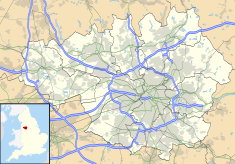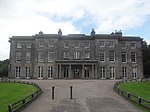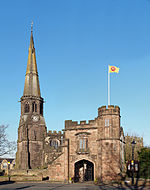
The Metropolitan Borough of Wigan is a metropolitan borough of Greater Manchester, in North West England. It is named after the main settlement of Wigan but covers a far larger area, extending up to 9 miles eastwards, including the towns of Atherton, Ashton-in-Makerfield, Golborne, Hindley, Ince-in-Makerfield, Leigh and Tyldesley. The borough also covers the villages and suburbs of Abram, Aspull, Astley, Bryn, Hindley Green, Lowton, Mosley Common, Orrell, Pemberton, Shevington, Standish, Winstanley and Worsley Mesnes. The borough is also the second-most populous district in Greater Manchester.

Hindley is a town within the Metropolitan Borough of Wigan in Greater Manchester, England. It is three miles (4.8 km) east of Wigan and covers an area of 2,580 acres (1,044 ha). Within the boundaries of the historic county of Lancashire, Hindley borders the towns and villages of Ince-in-Makerfield, Aspull, Westhoughton, Atherton and Westleigh in the former borough of Leigh. In 2001, Hindley had a population of 23,457, increasing to 28,000 at the 2011 Census. It forms part of the wider Greater Manchester Urban Area.

The Wigan Metropolitan Borough Council is the local authority for the Metropolitan Borough of Wigan in the United Kingdom. It consists of 75 Councillors with one-third being elected every three years in four. The borough is separated into 25 wards. Councillors are democratically accountable to the ward they are elected to represent. Each ward is represented on the council by three council members.

Westleigh, a suburb of Leigh, Greater Manchester, England, is one of three ancient townships, Westleigh, Bedford and Pennington, that merged in 1875 to form the borough of Leigh.

Leigh Town Hall is a municipal building in Leigh, Greater Manchester, England. It stands in Civic Square at the junction with Market Street, facing Leigh parish church. It was built in 1907 and granted grade II listed building status in 1987.

Atherton Town Hall is a municipal building in Bolton Road, Atherton, Greater Manchester, England. The town hall, which was the headquarters of Atherton Urban District Council, is now in use as a community hub and as a public library.

Nelson Town Hall is a municipal building in Market Square, Nelson, Lancashire, England. The building is the headquarters for both Pendle Borough Council and Nelson Town Council.

The Shire Hall is a municipal structure in Glanhwfa Road, Llangefni, Anglesey, Wales. The building, which served as the headquarters of Anglesey County Council, is a Grade II listed building.

The Old Town Hall is a building on Church Street in the market town of Poulton-le-Fylde in Lancashire, England. The building, which is located just beyond the northern end of Market Place, started life as a public house before becoming a municipal building and then reverting to use as a public house.

Lytham St Annes Town Hall is a municipal building on the South Promenade in Lytham St Annes, Lancashire, England. The structure, which is used as the headquarters of Fylde Borough Council, is a locally listed building.

Hunstanton Town Hall is a municipal building on The Green in Hunstanton, Norfolk, England. The structure, which is the meeting place of Hunstanton Town Council, is a grade II listed building.

Hanley Town Hall is a municipal building in Albion Square in Hanley, Staffordshire, England. The building, which is used as the local register office, is a Grade II listed building.
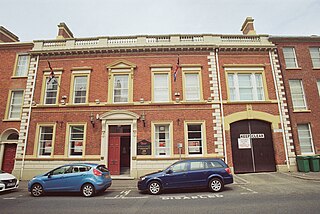
The Old Town Hall is a municipal structure in Castle Street, Lisburn, County Antrim, Northern Ireland. The structure, which is used as a constituency office by the Democratic Unionist Party, is a Grade B2 listed building.

Darvel Town Hall is a municipal building in West Main Street, Darvel, East Ayrshire, Scotland. The structure, which is used as a library and a community events venue, is a Category B listed building.

Denny Town House is a municipal building in Glasgow Road, Denny, Falkirk, Scotland. The structure is used by Falkirk Council for the provision of local services.

Woking Civic Offices is a municipal building in Gloucester Walk, Woking, Surrey, England. It is in use as the headquarters of Woking Borough Council.

Paisley Sheriff Court is a municipal structure in St James Street, Paisley, Renfrewshire, Scotland. The complex, which was the headquarters of Renfrewshire County Council and is currently used as a courthouse, is a Category A listed building.
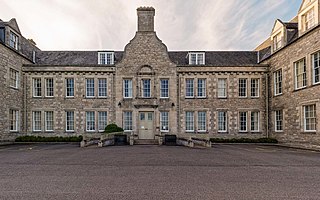
Drummuie, formerly Golspie Technical School, is a municipal structure in Drummuie Terrace, Golspie, Highland, Scotland. The complex, which was the headquarters of Sutherland County Council and is currently used as council offices for The Highland Council, is a Category B listed building.
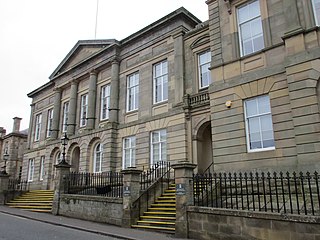
Lanark Sheriff Court is a judicial building in Hope Street, Lanark, South Lanarkshire, Scotland. The building, which continues to serve as the local courthouse, is a Category B listed building.

Lyme Regis Guildhall is a municipal building in Bridge Street, Lyme Regis, Dorset, England. The building, which serves as the meeting place of Lyme Regis Town Council, is a Grade II* listed building.

